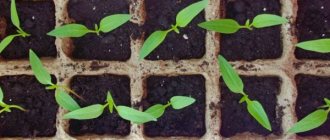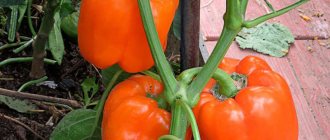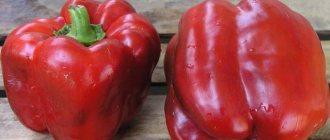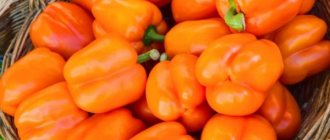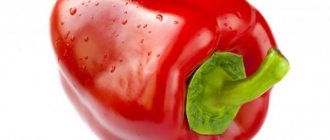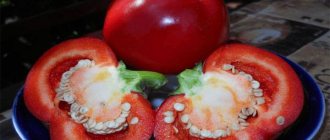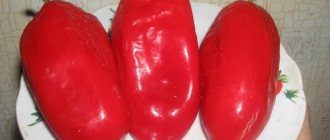Pepper's predecessors and neighbors
To maintain the health of the crop, crop rotation must be observed. It will prevent the appearance of diseases and pests on plants. The best predecessors of peppers: beans, peas, cabbage, cucumbers, zucchini, beets, carrots. It is not advisable to plant it after potatoes and tomatoes.
You can plant corn nearby, which will provide protection from cold winds. Onions and garlic, which secrete phytoncides, will protect the crop from harmful insects. You can also plant beans next to the peppers, which enrich the soil with nitrogen.
Note! Flowers with a pronounced scent will be good repellents: marigolds, calendula, geranium, tansy, fragrant rue.
Pepper trimming
During the growing season, the longest shoots are pruned, especially all shoots below the fork of the main stem are removed, as well as all branches going inside the plant. Perform pruning every 10 days and after harvesting the fruits.
To attract pollinating insects, spray the pepper plantings with a sugar or honey solution: 100 g of sugar, add 2 g of boric acid, dilute everything in a liter of hot water.
Mulching peppers with rotted straw (10 cm layer) will reduce the frequency of watering to once every 10 days.
Carry out gartering of plants in a timely manner; it is better to do this after hilling.
Arrangement of beds
Before growing bell peppers, carefully prepare the area.
In the fall, the soil is dug up and nutrients are added. You can use manure, humus, compost. Fertilizer is applied before digging at the rate of 4-5 kg per m².
In the spring, a mixture of superphosphate, potassium sulfate, and urea is used. In order for the sun to better warm the planting bed, it can be raised by covering it with boards.
A bed with plants can be covered with boards
Mr. Summer Resident Recommends: The Lazy Method of Growing Peppers
You can also grow peppers using the lazy method, which does not take much effort and time. To do this, you just need to follow some recommendations:
- Sowing seeds is carried out based on the illumination of the room. With enough sun: late March - early April. On window sills facing east or west: the last days of February or the first days of March.
- For better germination, seeds must be soaked.
- The soil is fertile: 1/3 of manure and a glass of ash per bucket of soil. A commercial substrate will also work.
- Picking is carried out after the first true leaves appear in small containers with a soil height of 5-6 cm.
- During the growth of seedlings, it is necessary to apply fertilizer 2-3 times.
- It is better to pinch early and mid-ripening varieties at the level of 5-6 leaf blades. This procedure will help the seedlings branch and adapt when transferred to a permanent place. However, the method must be applied to some seedlings. This will help you get the harvest at different times.
- Transshipment into open ground is carried out after June 10, and under film in mid-May.
- At first, mulch the soil. Layer - 5-6 cm of straw, humus, foliage.
- Fruits must be removed as they ripen and not left on the bushes.
Today there are more than 1,500 varieties of pepper. This allows gardeners to choose the appropriate option for growing both in open ground and in a greenhouse. By following the suggested recommendations for caring for the plant, it is easy to get a tasty and abundant harvest.
The best varieties and hybrids of pepper for open ground
Experienced gardeners recommend the following varieties and hybrids:
- Bogatyr. Refers to mid-season varieties. Fruit weight is 150-160 grams. During the period of technical ripeness, peppers are green, during biological maturity - red.
- Winnie the Pooh. From the emergence of seedlings to the start of fruiting, 110 days pass. The bushes do not exceed a height of 30 centimeters. The fruits are cone-shaped. Their weight is 50-60 grams. During the period of biological maturity, vegetables are colored red.
- Hercules. Belongs to late-ripening varieties. Fruiting occurs 140-145 days after emergence. Weight of red peppers - 150-160 grams. Vegetables have universal uses.
- California miracle. This is a mid-early variety. The weight of the cube-shaped fruit is 80-120 grams. The walls are 6-8 millimeters thick. The red fruits are tasty, sweet, aromatic.
- Claudio F1. Hybrid bushes reach a height of 70 centimeters. The fruits are cube-shaped, glossy. During the period of biological maturity, the pulp becomes red.
- Golden miracle. Mid-season variety suitable for open ground and greenhouses. Vegetables reach a weight of 180 grams. By autumn the fruits turn bright yellow.
Biological features
This herbaceous plant is essentially a perennial, but is grown as an annual. In total, there are four types of peppers in nature. And only one of them, Mexican, is a cultivated crop. The flowers are white, bisexual, the fruits of sweet peppers are from 5 to 22 cm, and those of hot peppers are smaller - from 1.5-2 to 5-7 cm. A sweet variety, when crossed with a hot one, can produce bitter fruits.
To maintain the purity of the variety, two different types of pepper are grown at a distance of at least 2 meters from each other.
Peppers are a heat-loving crop, predominantly neutral or short-day; seed germination occurs at a temperature of +8-13 C. The most favorable environmental factors for plant development are temperature conditions in the range of 18-25 C, air humidity not lower than 60 percent.
Lack of moisture in the soil leads to slower growth and, ultimately, to the death of the plant. For high yields, intensive feeding with humus and moderate illumination are required. It is better not to plant pepper on heavy soils, as well as on soils with high acidity and rich in salts.
It is recommended to grow peppers in areas that require improvement.
Agricultural technology for sowing seeds for seedlings
Sowing begins 50-60 days before planting the bushes in a permanent place. The substrate used is loose, air- and water-permeable. You can prepare it yourself from the following ingredients:
- turf land;
- peat;
- sand.
The soil is calcined, and boxes with low sides are filled ¾ full with it. Individual containers can be used. The seeds are placed on the surface of the soil, sprayed with water from a spray bottle, covered with substrate to a height of 0.5 centimeters, and lightly compacted. The containers are covered with film and placed at home in a warm place.
Diseases and pests
- The most dangerous pest for peppers is aphids. It settles on the leaves of the plant and feeds on its juices. It looks like very small (up to 3 mm) light green or black droplet grains stuck to the surface of the leaf, and especially on the buds. Treatment of plants affected by aphids with karbofos or keltan (1 tbsp per 10 liters of water) is very effective. It is important to remember that you cannot spray plants with them during flowering, as well as during the period of fruit ripening. In such cases, a folk remedy is suitable: a glass of tobacco dust or wood ash is steamed in a bucket of hot water. After 24 hours, filter the solution, pour in 1 tbsp. liquid soap and spray the plants (it is advisable to do this in the morning).
- If lightened spots appear on the leaves, they dry out, turn yellow, there are barely noticeable pests on their undersides, and in some places, and in advanced cases around the entire plant, a network of cobwebs is spread out - this indicates that the plantation has been attacked by a spider mite. The following mixture will help against it: onion or garlic (1 tbsp), dandelion (1 tbsp), liquid soap (1 tbsp). Vegetables and herbs are minced through a meat grinder and mixed with liquid soap in 10 liters of water. You can spray at any stage of plant development.
- Naked slugs eat not only the leaves, but also the pulp of the pepper. The resulting damage may cause the plant to die and the fruits to rot. Slugs have difficulty moving on loose soil, almost never cross deep obstacles, and are afraid of bitterness. If prevention in the form of deep furrows around the bed, frequent loosening to a depth of 3-5 cm does not help, then a teaspoon of dry mustard or ground red pepper, sprayed on each square meter of pepper plantation, will repel the slug.
- Blackleg - damage to the trunk of seedlings by bacteria under unfavorable weather conditions (lower temperatures and increased air humidity), which promote their reproduction. Sometimes it is enough to loosen the soil and sprinkle it with wood ash.
- More dangerous than blackleg are fungal diseases such as sclerocinia and fusarium. No remedies will help here - as soon as the pepper leaves begin to fall, all infected bushes should be burned immediately. The following year, this area cannot be replanted with pepper.
Growing seedlings
When sprouts appear, the covering material is removed. During the day, containers with plantings are kept at a temperature of 22-23 ° C. At night the temperature should not exceed 17-18 °C.
Attention! If necessary, seedlings located on the windowsill can be illuminated with phyto lamps to ensure a 12-hour day.
Picking
When the 2nd pair of true leaves appears on the seedlings, begin picking. To do this, each bush is planted in a separate container. Pepper does not tolerate transplantation well, so you need to act carefully, trying not to damage the root system.
Top dressing
2 weeks after transshipment, the seedlings are fed. For this purpose, special preparations are used, for example, Lux, Agricola. They can be purchased at a flower shop.
After another 2 weeks, Ideal and Kemira Lux are used. The preparations will not only feed the plants, but will also help boost immunity.
Hardening
In order for seedlings to safely survive planting in open ground, they need to be hardened off. To do this, 2 weeks before transplanting, containers with bushes are taken out into the yard for 30 minutes. Every day the time the seedlings spend in the air is increased. If pepper is grown in an apartment, it can be taken out to the balcony for hardening.
Peppers grown in individual pots will be easier to transplant
How to grow seedlings
Planting seedlings according to the Lunar calendar
Many gardeners follow the lunar calendar to choose the day to plant vegetables. Every year the days are different, but there is one rule - you need to land when the Moon is in the constellation of fertile signs (Pisces, Cancer). The query “Lunar calendar” can be entered into a search engine on the Internet and you will receive a comprehensive answer.
For myself, I looked at this link: https://mirkosmosa.ru/lunar-calendar/garden/2020/february. Lunar calendar for 2021. On February 6 and 7, 2021, the waxing moon will be in the constellation Cancer, and on February 24 and 25 in the constellation Pisces. Great time to sow seedlings!
What is needed for seedlings
So, to sow seeds you will need:
- the soil;
- pots or boxes;
- planting material.
Planting material, seeds, can be selected in any specialized store. Of course, with a huge number of multi-colored labels, the eyes run wild. What should you pay attention to when choosing varieties? How to choose bell pepper seeds?
How to choose seeds
First of all, you need to start with the choice of seeds, because the quality of seedlings and fruits depends on their quality. The choice of seeds depends on the area where you live. It is better to choose zoned selections. For the regions of Siberia and the Urals, the seed bags must have special marks: “Tested in Siberia,” etc. Also, pay attention to what is written about the ripening period. If you have a heated greenhouse, you can, of course, choose late-ripening peppers. But if you are going to plant peppers in an unheated greenhouse or in an open garden bed, then the choice should be on early and mid-ripening varieties. For the southern regions there are no special selection criteria, since bell pepper comes from warm regions and grows and ripens well there.
Seed treatment before planting
After seeds for planting are purchased, they need to be carefully inspected. Sort out damaged or too small seeds. They should not be used for sowing. Next, you should treat the fungus. Store-bought seeds are traditionally treated in advance; homemade seeds will need to be soaked for 25 minutes in a pink solution of potassium permanganate.
Treatment of seeds with potassium permanganate
In addition to traditional potassium permanganate, preparations such as Maxim and Vitaros are suitable for processing. They can also be purchased in specialized stores. Dissolve the drug in water, and wrap the seeds in a fabric bag and dip into the solution.
After this, place the seeds on a damp cloth, which you place in a very warm place (+25°C - +30°C), covering with a transparent lid to create a greenhouse effect. Wait until the seeds begin to hatch and sow them in the ground. It is very convenient to carry out the initial sowing in peat tablets. And when the sprouted pepper seedling gets stronger, without damaging the roots, place it together with the tablet in a larger pot, filling the space with specially prepared soil for pepper seedlings.
Sowing in peat tablets
Soil for seedlings
Choose light and loose soil for peppers. Recommended soil composition: one part peat soil, two parts humus, one part sand (I replace it with vermiculite). For 1 kg of soil mixture you can add 1 tablespoon of ash. All ingredients must be mixed thoroughly. Next, choose boxes or pots for planting seedlings. You should remember that the root system of peppers does not tolerate crowding, so narrow cups are only suitable for the first time, then they will have to be transplanted into wider containers. And one more important point - drainage must be placed at the bottom of the container to avoid stagnation of water and rotting of the roots.
Fill the drainage container with soil mixture and water it. For irrigation, warm water and a weak solution of potassium permanganate are used. After watering with potassium permanganate, it is better for the soil to stand, soak evenly and, as gardeners say, all components should become friends. Leave the soil alone for a day to allow the soil to mature.
How to prepare soil for seedlings at home
Sowing seeds
Pepper does not like transplants and picking. He gets sick for a long time after such procedures. Therefore, many gardeners prefer to sow immediately in a permanent place.
Or, as a second option, sow in peat tablets so that transplanting into a spacious pot is the least painful for the seedling.
The only thing you should immediately consider for the pepper is the possibility of adding soil from above, under the roots of the plants. Leave space in the container up to the top sides to add soil as the seedlings grow.
So, we sow the treated seeds into the prepared soil. Peppers are sown in a linear or checkerboard pattern, usually two seeds each, so that further selection of the best and strongest specimens is possible after germination. The distance between the seeds is 15 cm (if you are not going to replant later). The depth of sowing should be no more than 1-1.5 cm, otherwise the seedlings will be painful.
After sowing, irrigate the soil with a spray bottle. This simple device will allow you to gently moisten the top layer without washing out the seeds. Cover the container with seedlings with plastic wrap, secure along the edges of the containers and place in a warm place (near the heating). At the moment, lighting is not as important as heat. Therefore, the place where the container is located may be in partial shade, but it must be warm (+25 ° C).
Every day you need to open the film for 15-20 minutes and ventilate the soil. The soil should not be allowed to dry out. At this time, it is better to moisten the soil using a water spray bottle so as not to wash away the seeds. Watering the seedlings should be done with warm, settled water.
As soon as you see the sprouts hatching, remove the film and place the container with the seedlings on a light windowsill (preferably on the south side of the house).
Typically, sweet bell peppers sprout within a week, provided that the seeds have been well processed. When the seedlings hatch, lower the temperature to +18°C to allow the root system to develop properly. At the same time, this will be a kind of hardening. Then the temperature must be increased again.
Avoid drafts and cold windowsills for seedlings. Remember that pepper loves light, so the seedlings need to be illuminated with phytolamps so that the daylight hours are at least 14 hours (from 7 am to 9 pm).
Pepper is a heat-loving plant. The daytime temperature for growing seedlings should be 25C-27C, and at night it should be at least 13C.
To transplant into open ground, the height of the seedlings must be at least 20 cm, but they must not have time to bloom, otherwise the harvest will be meager.
Transplanting into open ground with straw mulch
Feeding seedlings
If you purchased a ready-made earthen mixture in a specialized store, then it already includes all the necessary mineral components for feeding seedlings.
If you use garden soil, it is possible to organize additional fertilizing. To fertilize seedlings, use the following solution: water - 0.5 liters; ammonium nitrate – 0.5 g; superphosphate – 3 g; potash fertilizers – 1 g.
It is recommended to fertilize 3 times during the entire period of seedling growth:
- the first feeding - when 2 full-fledged leaves appear, using a fertilizer solution in the specified quantities;
- second feeding - when there are 4 leaves or 14 days after the first, using a fertilizer solution, doubling the dose;
- third feeding - 2 days before transplanting seedlings into open ground, increasing the dose of fertilizer in the solution to 8g. At the same time, foliar feeding (spraying) should be done in order to obtain the best fruits.
Pepper planting dates
In open ground, growing peppers begins with planting seedlings. Plant plants in the garden after the threat of frost has passed. In order for home seedlings to grow quickly, they need to be planted in soil heated to 15-16 °C.
As a rule, peppers are planted at the end of May. If there is a threat of night frosts, the seedlings can be covered with film.
Important! The covering material should not touch the trunk and leaves of the plants.
Sweet pepper: growing and care in a greenhouse
Since pepper is a very heat-loving crop, its cultivation in open ground most often begins with seedlings. When sowing pepper seeds into the ground, they are carefully processed and well hardened. That is why many gardeners prefer growing bell peppers in a greenhouse, where ideal growth conditions can be created for the plant.
Growing bell peppers in a greenhouse
Glass, film greenhouses or hotbeds are used for planting seedlings or sowing seeds. It is also now widely practiced to grow peppers in a polycarbonate greenhouse.
Technology for planting bell peppers in a greenhouse
Peppers are planted in the greenhouse in early April. You can sow with seeds, but for better yield use 2-month-old seedlings 20-25 cm high, which already have 6 to 10 leaves.
Planting bell peppers in a greenhouse
- In the greenhouse, beds are prepared at a distance of half a meter from one another.
- Holes are made in them corresponding to the size of the container in which the seedlings grew.
- A solution of manure or chicken droppings is poured into the holes. To prepare it, half a liter of manure or a glass of droppings is dissolved in a bucket of warm water (about +50 C).
- 1 liter is poured into each well.
- Pepper seedlings are watered to remove them from the container by the roots.
- Then the peppers are planted in the prepared holes and tied to pegs.
Peppers in a greenhouse growing and caring
The main care for peppers in a greenhouse is to maintain optimal temperature conditions, water, regularly feed, weed and loosen.
Automated drip irrigation of peppers in a greenhouse
- The greenhouse must be ventilated and shaded in hot weather.
- Water the pepper every 2-3 days, pour 1-2 liters of water under the root of each plant.
- Growing peppers in a greenhouse involves maintaining optimal temperatures. During the day it should be at 20-27°C, at night - 15°C. After fruiting begins, it can be reduced by a couple of degrees.
- Bushes are earthed up when the soil is still moist. After the soil dries, it is necessary to loosen the row spacing.
Caring for peppers in a polycarbonate greenhouse does not differ from the rules of care in a regular greenhouse.
How to properly feed peppers in a greenhouse
Growing peppers in a greenhouse is impossible without sufficient nutrients. For feeding, urea is used in a similar proportion. But it is better to use a solution of bird droppings in water in a ratio of 1 to 15. Water 1 liter of it for each sprout. Before feeding, pepper care includes adding wood ash.
Fertilized pepper beds in a greenhouse
- The first feeding is carried out two weeks after planting in the greenhouse.
- The second is when fruit sets.
- The third is before harvest.
The composition of fertilizers can be the same for each of the procedures if the plant does not show signs of a lack of any microelements.
Caring for peppers in open ground
Growing sweet bell peppers is impossible without good care. It consists of watering, fertilizing, loosening the soil, forming a bush, fighting diseases and pests.
Watering
Irrigate the soil after the top layer of soil has dried. Plants especially need moisture during fruiting. If there is a lack of moisture, they will be small and wrinkled.
When watering the bushes, you need to take into account that water should not get on the trunk and leaves. How many times per season to irrigate the land depends on weather conditions.
Loosening
1-2 days after watering, the soil is loosened. The procedure prevents the appearance of a crust on the soil surface and promotes deep penetration of air. Loosen the soil carefully, since the root system of peppers is located close to the soil surface.
Top dressing
Nutrients are added to the soil under the bushes a month after planting. Use nitrogen, potassium, phosphorus. During the period of active fruit ripening, another fertilizing with potassium and phosphorus is carried out. Nitrogen is not used during this period to avoid fattening of the bushes.
Note! During the entire growing season, you can alternate root and foliar feeding.
Bush formation
In tall varieties of pepper, the stepsons are removed before the first fork. They take a lot of energy from plants, and fruits do not form on them. If desired, the gardener can remove several flowers. The remaining ovaries will form larger peppers.
Tall varieties need to be tied up
Disease and pest control
If not properly cared for, peppers can become infected with fungal diseases: anthracnose, fusarium, and blackleg. Fungicides are used for prevention and treatment.
For spider mites and aphids, Fitoverm, Actellik, and Karbofos are used.
How to grow in a greenhouse
If you decide to grow sweet peppers in a greenhouse, then the best time for this will be from mid-April to mid-May. But you need to look more specifically at the temperatures established in your region. In any case, measure the temperature of the soil in the greenhouse - it should be at least +15°C.
The following varieties are suitable for growing in greenhouses: “Bogatyr”, “Alenushka”; “Atlant”, “Winnie the Pooh”, “California Miracle” and many others. etc. But it’s not enough to just choose a variety; you need to follow the growing technology, starting with the selection of seeds and ending with harvesting the fruits.
Before planting the seedlings, string cords parallel to each other along the greenhouse at a distance of 35 cm, then make indentations of 15 cm every 20 cm.
These will be the holes in which the plants need to be planted. Plantings should not be thickened, as this affects the quality of the harvest. When planting seedlings in holes, pegs for garter are immediately installed, since if the pegs are installed later, the root system can easily be damaged.
In the first one and a half to two weeks, the pepper looks a little wilted, but do not be alarmed - this is its normal state. It is very important not to “flood” the plant at this moment. Your care for the vegetable at this stage consists of carefully loosening the soil around the plant, and thus providing it with additional oxygen. When growing this crop, watering before flowering occurs twice a week, after the appearance of flowers, ovaries and fruit growth, it becomes more abundant and must be done at the root, preferably with warm water (about 22 degrees). The ideal type of irrigation is the drip method.
How to fertilize
Experienced gardeners say that the best option for feeding peppers is active mulching with freshly cut grass. Moreover, the thicker the layer of mulch, the better. And then the inhabitants of the soil will do everything for you. By recycling the mulch, they will feed the soil with the organic matter your garden needs.
It is not the plant itself that needs to be watered, but the grass laid out in a layer on top of the soil. There is one rule for mulching: you cannot dig up the soil along with the mulch, otherwise putrefactive processes will begin to form, which will lead to pepper diseases. The mulch should remain on the surface of the bed until the end of the season. More details in the next video.
Active mulch (video)
How to care
When growing sweet peppers, we must not forget that this plant is quite fragile and is susceptible to breaking off not only leaves if handled carelessly, but also entire branches. Further care and cultivation technology boil down to timely watering of the plant, mulching and staking. What about weeding? And there is no need for weeding during active mulching! If the grass grows through the mulch, the mulch layer is too thin. Add freshly cut grass and problems solved.
Watering
Depending on weather conditions and soil conditions, peppers are watered 1-2 times a week. From the moment the plants bloom, they are watered abundantly with warm water, the temperature of which should not be lower than 22C°. Watering must be done strictly at the root, so as not to provoke the development of diseases.
And remember, cold water significantly slows down growth.
During the flowering period, sweet peppers become interesting to such uninvited guests as aphids and spider mites. Aphids feed on leaves, stems and flowers, while mites suck sap from leaves. However, don't panic, getting rid of them is not difficult at all. When the first signs of plant damage by pests are detected, treatment should be carried out using traditional methods (a solution of water with laundry soap, ash, tobacco, sunflower oil, etc.) and bacterial preparations, such as Fitoverm.
How to get rid of aphids in the garden forever
How to grow a big one
Everyone dreams of growing juicy, sweet and large bell peppers. What secrets do gardeners have to ensure that the plant pleases with large fruits? Knowledgeable vegetable growers use pinching and removing the top of the stem to form powerful bushes. As soon as the plant reaches 25 centimeters in height, you need to remove the top so that the bush begins to branch. By removing excess shoots, we give the remaining fruits the opportunity to grow better, gain strength and reach larger sizes.
The nuances of growing in different regions
In central Russia, peppers are safely grown in open ground. Breeders have developed many varieties that are intended for these purposes. In the Moscow region, the crop is planted in open or closed ground. In the conditions of the Urals, Far East, and Siberia, greenhouses are built for growing pepper. They are covered with film, polycarbonate, glass.
In cold regions, peppers are grown indoors
Choosing a Pepper Variety
The choice of variety for cultivation should be based not only on the taste of the fruit, but also on its purpose. If you plan to eat the pepper fresh, then large, fleshy fruits with thick walls are suitable. For winter preparations, it is better to choose smaller and denser ones.
Another nuance is the planting climate zone. For example, in the Urals, with the help of modern covering materials: various types of films and polycarbonate, high yields can be achieved. Grow even late varieties of foreign selection. However, it is better to choose early and mid-season peppers. In height, low-growing bushes are suitable for cold regions.
The following table will help you understand the characteristics of each variety and make your choice:
| Name | Ripening time (days) | Height (cm) / Weight (g) | Peculiarities |
| Atlant | Early, 100-110. | 70-75. 180-200. | Compact, large number of fruits. |
| Black sugar | 80. 70-95. | Unusual dark purple color. | |
| Winnie the Pooh | 25-30. 50-70. | Productivity is not very dependent on weather conditions. | |
| Hercules | Mid-season, 130-140. | 75-80. 220-300. | Great for freezing and processing. |
| Gold | Mid-season, 115-120. | 30. 110-180. | Universal variety. |
| Gladiator | Medium late, 150. | 40-55. 160-350. | Resistant to many diseases. |
| Ermak | Early ripening, 95. | 35-45. 53-70. | |
| Merchant | Early, 110. | 70-90. 60-130. | Sweet taste. |
| California miracle | Early ripening, 100-130. | 70-80. 80-160. | Suitable for fresh consumption and any type of culinary processing. |
| Aphrodite | Mid-early, 110-115. | 80-85. 170-220. | |
| Fatty | Mid-season, 115-118. | 50-55. 130-200. | Easy to care for. |
| Belladonna | Early ripening, 55-60. | 60-80. 120-170. | Grows in open ground and under film. |
| Firstborn of Siberia | Mid-season, 100-110. | 40-45. 50-55. |
When planting several different varieties, it is important to space them out into distant areas of the garden or separate them with other tall crops such as tomatoes or corn. This is due to the rapid transfer of pollen from one bush to another.
Expert advice
Experienced gardeners know how to grow peppers in open ground. They share secrets and give the following advice:
- Seedlings are planted after stable warmth arrives.
- Tall varieties need to be tied to stakes. Otherwise, fragile trunks may break.
- The lower shoots are removed.
- Loosening is done carefully, since peppers have a superficial root system.
- To increase productivity, the bushes are fed several times a season.
Growing peppers is a fascinating process. The culture does not require special care. After studying the information, the gardener will understand how to grow and harvest a good harvest of peppers in his garden.
Planting in the ground, seedling planting scheme
The yield depends on the correct planting of peppers in open ground, since dense placement will lead to fungal diseases and rotting of the stems, and too loose placement will lead to excessive lighting and burns of the fruit. Landing can be done in 2 ways:
- Plant 1-2 bushes per nest at a distance of 35-40 cm with row spacing of 70 cm.
- The distance between the bushes is 20-25 cm, the row spacing alternates between 30 and 70 cm.
Two-line planting
In the second case, 2 close lines are obtained, as a result, the number of plants planted in the same area as in the first case increases. It should be taken into account that tall varieties and hybrids that require garter require a larger feeding area. A day before planting, the seedlings are watered, the planting holes are prepared so that the plants fit in them with a lump of earth, but the root collar remains on the surface. Then:
- pour 1 tbsp into the holes. l. potassium fertilizers (without chlorine) or 1 tbsp. ash and 2 handfuls of humus, if it was not added earlier;
- spill them with a pink solution of potassium permanganate;
- remove the seedlings from the pot, being careful not to disturb the integrity of the earth and roots;
- lower the bush into the hole;
- sprinkle with earth;
- compact it with your hands, creating a watering ditch;
- water;
- mulch with rotted sawdust, peat or humus.
Planting rules provide for it to be done in the evening or on a cloudy day.
Basic growing conditions
There are many factors that influence the successful cultivation of sweet peppers, but the main ones are light, soil fertility, temperature and watering. When planning to grow seedlings yourself, you need to know these points:
- The soil must be fertile, the reaction is closer to neutral. The introduction of peat is undesirable.
- The duration of daylight should be at least 12 hours. If it is shorter, this will affect the development of seedlings.
- The air temperature for varieties is 26-28 °C during the day and 20-24 °C at night, for hybrids - 29-31 °C during the day and 23-27 °C at night. At temperatures below 18 °C, plant growth stops.
Particular attention should be paid to watering. Pepper is a crop that requires water, but does not like waterlogging. Wet the seedlings in the morning so that by night the soil is almost dry.
It is better to water sweet pepper seedlings with warm water, standing at room temperature.
Growing peppers from seeds
How to sow seeds
Sweet peppers in our latitudes are usually grown by seedlings. The timing of sowing seeds for seedlings depends on climatic conditions, but in any case, sweet peppers are sowed no later than the beginning of March.
Planting pepper seedlings begins with pre-sowing seed treatment: first, they are dipped in water at a temperature of 50 ºC for five to six hours to swell, then, wrapped in a damp cloth, they wait 2-3 days at a temperature of about 20 ºC until the seeds hatch, and only after that they are sown in the ground. This preparation of seeds accelerates their germination, and seedlings can appear within 2-3 days after sowing.
- TOP 10 reasons for a bad harvest
Soil for pepper seedlings is prepared as follows: 2 cups of garden humus are mixed with 1 cup of sand, one cup of garden soil, add a spoon or two of wood ash, stir well and sterilize this mixture in the oven or in the microwave, after which it is still hot, put in boxes, leveled , allow to cool to 40-45 ºC and place the seeds on it at intervals of 5 cm from each other with a depth of 1.5-2 cm. But it is better to place the seeds in peat pots, since pepper does not tolerate picking well. The crops must be watered, and then cover the seedling containers with polyethylene or glass and place in a warm place - the temperature required for seed germination is 21-22 ºC.
Growing seedlings
Growing pepper seedlings is not much different from growing seedlings of any other vegetable. As soon as the first shoots appear, the temperature in the room is increased during the day to 26-28 ºC, and at night the seedlings need coolness - 10-15 ºC. Monitor the soil moisture in containers with seedlings - it should be moderate, since in too wet soil the plants can get blackleg. However, the soil should not be allowed to dry out. Water the seedlings with settled warm water - approximately 30 ºC; from cold water the seedlings get sick, wither and die.
Caring for seedlings involves creating high air humidity in the room, so seedlings should be sprayed from time to time. In addition, regular ventilation of the room is necessary, but do not expose the seedlings to a draft. You may need to provide additional lighting for the seedlings, since they need to be exposed to light from 7 a.m. to 9 p.m.
Pepper picking
In the development phase of the seedlings' first pair of leaves, they are picked. If you sowed seeds in peat pots, then you do not need to pick, but if your seedlings grow in boxes, when picking, the seedlings are placed from the boxes into peat pots measuring 8x8 cm and buried in the ground up to the cotyledon leaves.
Once the picked peppers have taken root in the cups, they begin to develop intensively, and shortly before the solemn moment of planting the seedlings in open ground, they begin to accustom them to the environment in which they will find themselves: the seedlings are taken out into the fresh air every day, at first for a short time, but gradually the time spent in increase in new conditions, preventing seedlings from being exposed to drafts or “frosts” below 13 ºC.
Before planting seedlings in open ground, peppers are fertilized, at least twice: two weeks after picking or in the phase of formation of the first pair of leaves in the seedlings, and then another two weeks later, or when the seedlings develop the second pair of leaves. It is better to apply fertilizer in liquid form. The best fertilizers for seedlings are Agricola, Mortar, Krepysh, Fertika Lux.
Growing peppers on a windowsill
In order to grow sweet peppers at home, you will need self-pollinating seeds, a good substrate, a phytolamp and a place in the apartment where the sun shines for at least 3-4 hours a day. Once your potted peppers begin to bloom, shake them at least once a day to ensure successful pollination. Large fruits take a lot of energy from the bush, so leave 5-6 ovaries for ripening and remove the rest.
Fruit-bearing crops quickly deplete the soil in which they grow, so it is necessary to feed the pepper bush once every 2-3 weeks, adding a teaspoon of Agrolife to the top layer of soil or watering the soil with a solution of one capful of the drug Growth in two liters of water.
At home, sweet pepper is a perennial plant, and it wouldn’t hurt to add fresh vermicompost to the pot every two months while the container allows, or replant the bush into larger pots when the need arises. To extend the life of the plant, it is advisable to carry out a small annual spring rejuvenating pruning of the pepper, and then you are guaranteed a fruit harvest for several years.
Soil preparation
The area for the beds for growing peppers is prepared in the fall: the remains of the plants of the previous crop and weeds are removed from the ground, everything is dug up to a depth of at least 0.3 meters. At the same time, fertilizers are added to the soil - humus in an amount of 5-10 kg per square meter. m, ash in the amount of 50-80 g and superphosphate - 30-50 g. Fresh manure is not applied to the pepper: it will stimulate the growth of greenery, not ovaries and fruits.
The area is left until spring. When it gets warm, the clods of earth are leveled and the beds are left until the day the seedlings are planted on them. If fertilizers were not applied in the fall, then this can be done in the spring, but in this case, preference should be given to mineral fertilizers: apply nitrate at 40-50 g per 1 sq. m. m, potassium-phosphorus fertilizers 30-40 g.
You don’t need to add a lot of nitrogen, pepper is sensitive to its excess: if there is an excess of nitrogen in the soil and a lack of other elements, then the above-ground part of the plant will grow vigorously, it will bloom poorly, set fewer fruits, and they will be smaller.
Preparing containers and soil for seedlings
The container for growing pepper seedlings can be almost anything - plastic containers, wooden boxes, cut-off water bottles, even clay pots. The main thing is not to use peat containers; in them, the pepper will begin to lag in growth, suffer from a lack of moisture and a poorly developed root system.
If different containers are used for seedlings, good drainage must be ensured. To do this, holes are drilled or burned with a hot nail in the bottom of the containers. Any container, even one purchased in a store, must be disinfected. To do this, use a solution of potassium permanganate or any fungicide; irrigation with hydrogen peroxide will not harm.
Preparation of soil mixture
In most cases, it is impossible to grow peppers in soil taken from the garden. The acidity of the soil in it will probably be higher than recommended, and the nutritional value will be lower. Therefore, you will have to either buy a soil mixture or prepare it yourself. The second option is cheaper, but takes time.
The following soil mixture recipe is suitable:
- soil from under deciduous trees (except oak and chestnut) - 2 parts;
- sand, maybe river sand - 1 part;
- peat - 1 part.
All ingredients are mixed, then 2 cups of wood ash are added to the bucket of the finished mixture and mixed again. Instead of ash, you can add two tablespoons of potassium fertilizer and a tablespoon of superphosphate.
You can prepare another composition by mixing turf soil, humus and sand in a ratio of 2:2:1. The composition is also strengthened by adding mineral fertilizers.
As for the finished soil, you need to study the composition - peat is added to some mixtures. If there is a lot of it, then the soil reaction will be acidic, and this will negatively affect plant growth. The problem can be partly solved by adding soil for growing indoor plants in a 1:1 ratio, but this is a last resort solution when other options cannot be implemented.
Soil disinfection
Purchased soil, especially one enriched with bacteria, does not need to be disinfected. It’s another matter if the mixture was prepared independently using turf or forest soil - it may contain pathogens of various diseases of pepper and other garden crops.
You can disinfect the prepared soil mixture in the following ways:
- Take the soil out into the cold or place it in the freezer for 2-3 days. The temperature should not be higher than -18 °C. Then the soil is kept warm for a week and frozen again. The method is not suitable for compositions containing vermicompost or humus.
- Spread the soil mixture on a baking sheet in a layer of no more than 5 cm, pour boiling water over it and place in an oven preheated to 90 °C for half an hour. It is important not to over-expose, otherwise there will be no nitrogen in the composition.
- Pour the soil mixture into a colander and hold over boiling water for 10 minutes, stirring occasionally. This treatment kills all bacteria, including beneficial ones.
The most effective and safest method of disinfection is treatment with fungicides. You can use ready-made preparations: Baikal EM-1 or Fitosporin. A solution of potassium permanganate will not harm either.
Disinfection methods also kill beneficial microflora, and therefore should be used with caution. It is better to treat the soil with them before mixing with bio-components.
When to sow seeds for seedlings
Sweet peppers take a very long time to sprout, and then grow slowly. Between sowing seeds and the appearance of seedlings, 10-20 days pass, and seedlings grow in about 90-100 days. Therefore, seeds should be sown as early as possible. Usually the work is carried out in the first half of February, but in the southern regions some gardeners sow sweet peppers already in the third or fourth decade of January. The main thing in this matter is not to sow the pepper too early, otherwise you will have to do additional lighting, and not everyone succeeds.
Sweet peppers can be sown for seedlings from February 15 to March 15. More precise timing can be obtained from local gardeners.
Agrotechnical conditions
Bell pepper has established itself as a rather fastidious plant to grow. To create favorable conditions for its growth and development, you will have to try a lot. But knowing the agricultural technology of growing sweet peppers, you can reduce the labor intensity of this process.
Climatic conditions
This heat-loving representative of the Solanaceae family was bred by Bulgarian breeders; its homeland is South America. The semi-shrub plant has a long ripening period; 160-180 days pass from sowing the seeds to harvesting the fruits. Unlike natural growing conditions, peppers in Siberia are grown taking into account the characteristics of the cold climate. Varieties are selected with a high degree of resistance to adverse environmental factors and early ripening (Kolobok, Sibiryak, Topolin, Novosibirsky).
Soil requirements
To grow a good pepper crop on your plot, you need to take into account the requirements of the vegetable crop regarding the composition and structure of the soil. Best of all, the semi-shrub plant grows on light, water-breathable, fertile soil.
If the garden has sandy loam soil, then it is more effective to plant varieties with early ripening, and on loamy soil and chernozems that can retain moisture for a long time - mid-season and late varieties of bell pepper.
You should not count on a rich harvest when growing on clay and sandy soil; these types of soil are not suitable for this crop. But they can be cultivated by adding sand, brick chips, mature compost, chopped straw for heavy loam to improve digging. But for sandy soil they use clay, bone meal, composted peat, vegetable compost, and manure humus.
Crop rotation norms
To grow healthy peppers in the garden, you should not neglect the rules of fruit rotation. Every gardener should know which crops are planted after sweet peppers, and which plants are his best companions. So, if you plant bush beans nearby, this will be a natural protection against parasitic individuals that attack bell peppers. Pests cannot tolerate its specific smell, and such plantings act as an insurmountable obstacle for them. In addition, the proximity to representatives of legumes provides the southern crop with nitrogen, which it greatly needs.
To protect against through northern winds, corn is sown near the pepper plantings. Thanks to such a hedge, gardeners save young seedlings sensitive to cold. Among the predecessors, it is better to choose pumpkin, carrots, zucchini, cucumbers, and squash. These agricultural crops perfectly saturate the soil with useful components and make its structure quite loose.
A positive result is also observed when growing sweet peppers after onions and garlic. But planting it in beds where eggplants, physalis, potatoes, tobacco and tomatoes previously grew is not recommended due to common diseases and pests.
Planting seedlings
Bell pepper is a heat-loving plant. Young specimens are planted in the soil after the threat of spring night frosts has passed. The time for planting seedlings depends on the regional location of the dacha. As a rule, peppers are planted starting in mid-May. Bell pepper seedlings for open ground must undergo a hardening process. To increase resistance to adverse factors, plants should be taken out into fresh air in warm weather. Hardening of young individuals is carried out gradually, starting from several minutes.
Planting pattern for peppers 70x30 cm or 50x50 cm:
- A few hours before planting, young plants are watered abundantly. The culture at the time of transplantation should be vigorous and healthy. Lack of moisture can have a detrimental effect on the establishment process. Withered plants shed their first buds and retard their development. A weak and wilted plant during transplantation means a significant reduction in yield.
- Young seedlings are planted in the afternoon. At night, the culture will not fight the sweltering heat and will devote all its energy to survival. In the case when it is cloudy outside, pepper seedlings can be planted at any time of the day.
- Prepare holes in the soil for planting plants. Each hole should be watered generously: 2 liters of water per plant. It is best to use water for irrigation at room temperature, heated in the sun.
- The seedlings are transplanted with a ball of earth. Each plant should be separated from the container and planted in the prepared holes not too deep: plant the pepper 3 cm deeper than it grew in room conditions. Pepper does not form adventitious roots well. But still, their appearance contributes to better nutrition of the crop.
The plant is not picky about the composition of the soil. But it still grows better on loamy soil.

